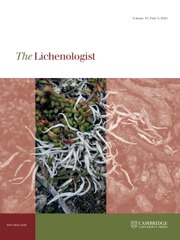Article contents
Diffuse growth in the fruticose beard lichen Ramalina usnea (L.) R. Howe
Published online by Cambridge University Press: 29 January 2015
Abstract
Very little is known about how growth is distributed within thalli of fruticose lichens. To determine whether mature, non-apical regions of the beard lichen Ramalina usnea elongate, segments of the broadest axes were marked with thread and measured; thalli were then returned to the field to resume growth for about one year. Growth was evident in all segments measured and increments were roughly proportional to length, suggesting that elongation occurs throughout the thallus. New thallus axes (branches) were organized from buds that emerged from mature tissue, usually along pseudocyphellae and surfaces exposed by breakage. Axes were very fine at their extremities and possessed an inrolled apex from the time of bud emergence. No evidence of apical branching was observed. The thallus cortex consisted of very thick-walled fungal cells oriented longitudinally. In transverse section, cells gave the appearance of being grouped within fascicles, indicating that branch cells grow within the older cell wall material of their neighbours, as occurs in the cortex of Ramalina menziesii and the medullary cord of Usnea longissima. A continued accumulation of cell wall layers may be related to the mature tissue's capacity to sustain elongation growth.
Information
- Type
- Articles
- Information
- Copyright
- Copyright © British Lichen Society 2015
References
- 6
- Cited by

